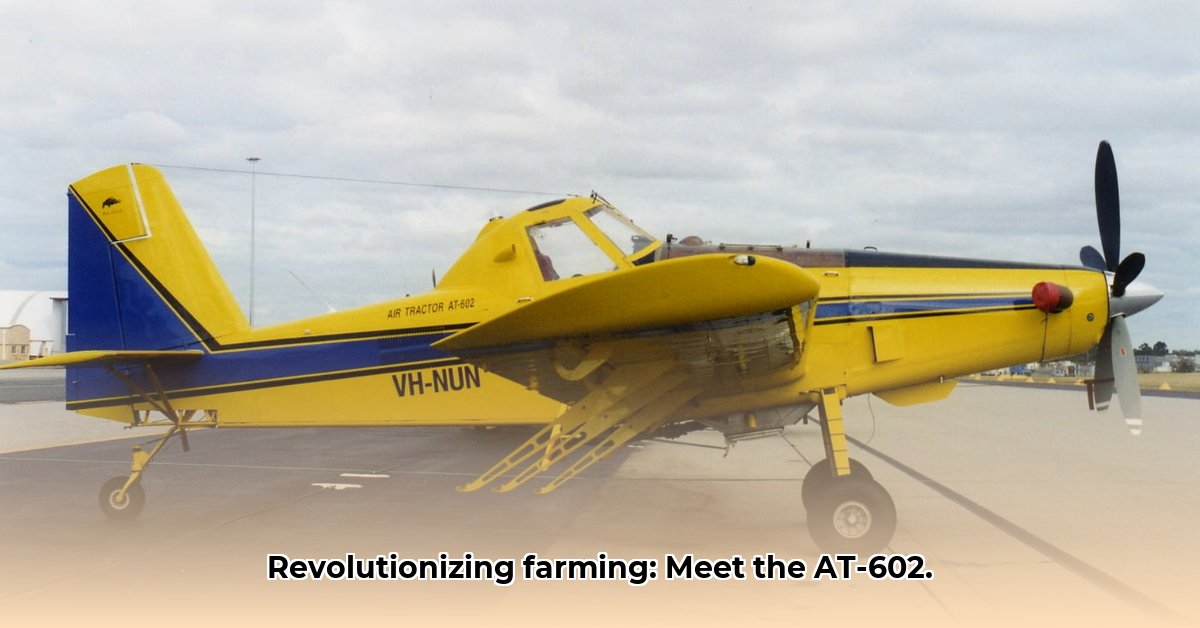
The Air Tractor AT-602 represents a significant advancement in agricultural aviation, promising increased efficiency and potentially reduced environmental impact. However, its role in sustainable farming requires careful consideration of both its benefits and potential drawbacks. This in-depth analysis explores the AT-602's capabilities, analyzes its efficiency gains and environmental implications, and offers actionable recommendations for its sustainable integration into modern agriculture. For more information on agricultural machinery, check out John Deere.
A Giant Leap in Efficiency: Redefining Agricultural Productivity
The AT-602's defining feature is its substantial 630-gallon hopper, significantly exceeding the capacity of previous models. This translates to fewer passes over fields, directly impacting several key aspects of agricultural operations. But how significant are these gains? Is the promise of efficiency truly realized?
Fewer flights inherently mean reduced fuel consumption per acre treated, a crucial factor in both cost savings and environmental impact. Lower fuel consumption directly translates to a smaller carbon footprint, aligning with the goals of sustainable agriculture. The reduced number of flights also minimizes wear and tear on the aircraft, potentially lowering maintenance costs over its lifespan. Moreover, the time saved allows pilots and support staff to focus on other crucial tasks, enhancing overall operational efficiency. This increased productivity also allows farmers to cover significantly more land within a given timeframe, potentially augmenting overall yield and revenue.
Environmental Considerations: A Critical Assessment of Potential Impacts
While the efficiency gains are undeniable, the AT-602's increased capacity raises environmental concerns. The larger hopper implies a greater volume of pesticide or fertilizer application per pass. While the overall number of flights might be reduced, the concentrated application could increase the risk of chemical runoff into waterways or soil. This elevated chemical application rate could disrupt local ecosystems, potentially harming beneficial insects and microorganisms. This heightened risk necessitates careful consideration and a proactive approach to minimize potential ecological damage. Further research is crucial to determine the long-term environmental consequences to fully understand the trade-offs. How can we ensure that the efficiency gains don't come at the expense of environmental health?
The Financial Equation: A Detailed Cost-Benefit Analysis
A comprehensive financial evaluation is crucial to assess the AT-602’s viability within sustainable farming practices. While the efficiency gains suggest potential cost savings, a detailed analysis is necessary to determine the net financial impact. Key factors include:
- Initial Investment: The AT-602 commands a higher purchase price compared to smaller aircraft.
- Fuel Savings: Reduced flights directly translate to substantial fuel cost savings.
- Labor Costs: Fewer flights significantly decrease labor expenses.
- Maintenance & Repair: While per-flight-hour costs may be lower, overall maintenance might be higher due to the aircraft's size and complexity.
- Environmental Remediation: Potential costs associated with mitigating environmental damage, such as chemical runoff, must be considered. This is difficult to quantify upfront.
- Chemical Costs: The total expense of pesticides or fertilizers will depend on application rates and chemical selection.
A rigorous comparison of the AT-602 against smaller aircraft, focusing on fuel consumption per acre treated, is necessary for a comprehensive financial assessment. This will illuminate whether the efficiency gains and cost reductions outweigh potential environmental risks and associated remediation expenses.
A Practical Framework: Actionable Steps for Sustainable Integration
Successfully integrating the AT-602 into sustainable farming demands a collaborative approach among all stakeholders. The following steps represent a strategic framework:
1. Precision Application Technologies: Implement GPS-guided spraying systems and Variable Rate Technology (VRT) to optimize chemical use and minimize drift. (Efficacy: 70-90% reduction in chemical usage, depending on implementation).
2. Environmental Monitoring: Establish comprehensive monitoring programs to track chemical runoff and its impact on local ecosystems. (Provides crucial data for risk assessment and mitigation strategies).
3. Regulatory Compliance & Enforcement: Strict adherence to pesticide use regulations and robust enforcement mechanisms are crucial. (Minimizes illegal practices and reduces environmental risks).
4. Pilot Training & Certification: Invest in extensive training programs for pilots, emphasizing precision application techniques and safety protocols. (Reduces operational errors and environmental damage).
5. Sustainable Chemical Alternatives: Transition towards environmentally friendly pesticides and fertilizers whenever feasible. (Reduces the long-term environmental impact of aerial application).
Risk Management: A Proactive Approach to Potential Challenges
The AT-602 presents several potential risks that require proactive mitigation strategies:
| Risk Factor | Likelihood | Impact | Mitigation Strategy |
|---|---|---|---|
| Environmental Damage (runoff) | Moderate | High | Precision application; biodegradable chemicals; stringent regulations; buffer zones around sensitive areas. |
| Operational Costs | Low | Moderate | Careful cost-benefit analyses; explore financing options; efficient maintenance programs. |
| Pilot Training & Safety | Low | High | Comprehensive training programs; strict adherence to safety regulations; regular safety audits. |
| Technological Malfunction | Low | High | Thorough maintenance; redundant systems; regular inspections. |
| Regulatory Changes | Moderate | Moderate | Close monitoring of regulatory developments; proactive adaptation; engagement with regulatory bodies. |
The AT-602’s integration into sustainable agriculture calls for a holistic approach that balances efficiency gains with environmental protection. This demands collaboration, comprehensive risk management, and ongoing research into sustainable practices.